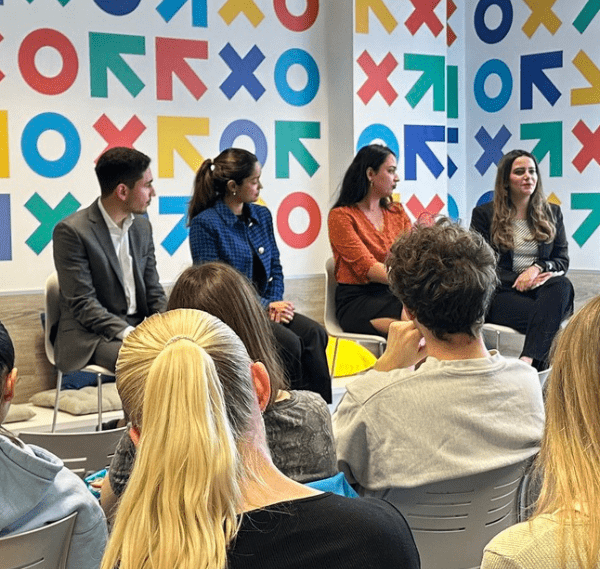In our social lives, we might exclusively spend time with our peers: people our own age with similar lifestyles and circumstances. In the workplace, this all changes. Work is one environment where we can expect to coexist and collaborate with people of diverse experiences.
One area of difference we’re likely to encounter relates to our use of technology. That’s because the generation someone was born in can have a huge influence on how they approach digital tools. This issue is often discussed using a framework that categorizes people as either digital natives or digital immigrants.
Read on to learn more and to discover which label applies to you.
Defining digital natives and digital immigrants
These terms were coined by Mark Prensky in 2001 to describe two contrasting attitudes to technology. His article suggested that there are observable differences in technology adoption between those who were born before it became ubiquitous, and those who have been saturated in the digital world for their entire lives.
A comparison with language usage can be made. Language comes more naturally to someone who is native and has been speaking it all their lives. A native language speaker will instinctively understand aspects of their own language that would need to be explicitly taught to a second language speaker who is learning at a later stage of life.
In terms of technology, this means that digital immigrants may take more time to understand and adopt a digital tool. Digital natives may “get it” faster or prefer to learn as they go.
This makes sense when you consider that digital immigrants have had to adapt and participate in the transition between an offline life and life as it is now. Digital natives, in contrast, have only ever known a digital world. They’re very comfortable in it.
The criteria of these categories could be contested. Membership in Generation X means you’re considered a digital immigrant, whereas being part of Generation Z definitely qualifies you as a digital native. Where does that leave millennials? The cutoff year has been established as 1980, but is there really that much difference between someone born in 1979 and someone born two years later?
Perhaps the best way to determine whether someone is a digital native or a digital immigrant is to actually observe their attitude and approach to new technology.


Digital natives and digital immigrants in the workplace
So, what can you expect from colleagues who are digital natives, and how do they compare to digital immigrants? You may notice that digital immigrants prefer to talk about issues in person. Where digital natives may send over an email or an instant message, digital immigrants often prefer to express themselves in a conversation.
Digital immigrants and digital natives tend to differ in their learning styles, too. If you’re responsible for introducing a new digital tool to your colleagues, you might find that digital natives grasp it quickly and intuitively. Digital immigrants will usually require more logical, step-by-step instructions.
Because they have grown up with their phones in their hands, digital natives can multi-task without even thinking about it. They often find it easy to switch quickly between tasks. Digital immigrants are different in this respect. They prefer to focus on one task at a time and give it their complete attention.
Another big difference between digital natives and digital immigrants is where they go to access news. While digital natives are more likely to choose social media and specific blogs for updates, digital immigrants may see traditional media such as newspapers and television news programs as superior sources.


Myth-busting about digital natives and digital immigrants
As with any sweeping generalization, you should be very careful about how you apply labels such as digital native and digital immigrant. Used incorrectly, as a tool for judgment rather than to enhance understanding, they can perpetuate harmful and inaccurate myths.
Here are four misconceptions you should avoid promoting when talking about digital citizenship:
- Age is the only important factor
Actually, there are many factors that combine to form someone’s digital citizenship. For example, a young person from a low-income background with very little technology in the home is unlikely to have the same familiarity with digital tools as an older person with the resources to invest in cutting-edge technology. - Immigrants are inferior to natives
These categories should not be used to say one group is superior to another. Instead, they should alert us to differences, and every difference represents both challenges and opportunities. Digital immigrants also bring unique advantages to the workplace. For example, they might be less likely to be scrolling their phones during a training session! - Immigrants can’t be taught new tech
Rather than letting the label of “digital immigrant” imply a deficiency, it should inform how we introduce new technology. Digital immigrants are just as capable as digital natives when it comes to mastering new tools. It is simply the approach and the time they take that are different. - Exposure is the same as mastery
Just because younger generations have been exposed to technology to a greater degree doesn’t mean they have fully mastered it. In fact, a digital immigrant who has taken the time to learn the ins and outs of a new tool may understand it at a higher level than a digital native who assumes instinctive knowledge.
Building bridges between digital natives and digital immigrants
Workplaces can create a comfortable environment in which both digital natives and digital immigrants can thrive by introducing a few simple measures:
- Provide clarity where necessary, flexibility where possible
Companies can introduce clear protocols regarding when in-person meetings are necessary and when digital communication will suffice. This removes a potential area of conflict between the two groups. In less contentious situations, they can allow employees flexibility to choose the best method for them. - Cater to a range of learning styles
Development opportunities should be offered in different formats. Some people may prefer in-person, step-by-step training whereas others would rather participate independently in an online course. Although it may require additional investment, offering both is the most supportive approach. - Introduce reverse mentorship
Digital natives and digital immigrants have a lot to learn from one another. Reverse mentorship programs allow younger workers to benefit from the knowledge of their more experienced colleagues, just as traditional mentorship programs do, but they also ask digital natives to share their wisdom by training their mentors in new technology. This can help build relationships of respect between the two groups.












